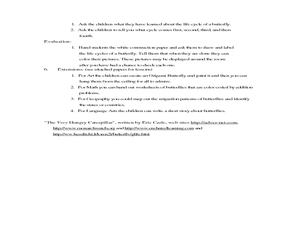Curated OER
Brine Shrimp Anatomy
Third graders investigate the anatomy of the brine shrimp. They construct a model of the shrimp to demonstrate the anatomical parts of the shrimp. Students research the different factors that contribute to shrimp survival. Then they...
Curated OER
Bringing Up Birdy
Learners explore biology by creating diagrams of animal life cycles. In this baby bird lesson, students view video clips of birds being born from incubation to flying on their own. Learners utilize the Internet to research birds and...
Curated OER
Grapevine Magic
Pupils explore plant uses. Students observe the process of changing grapes to raisins as a method of preserving a plant part for human use.
Curated OER
Life Cycle of a Butterfly
Learners complete a variety of exercises involving butterflies and their life cycle.
Curated OER
Flower Power
Students use video learning to explore how flowers make seeds and dissect their own flower, and make a flower with its reproductive parts out of construction paper.
Curated OER
Classroom Animals & Pets - Insects & Company - Butterflies
Students examine the life cycle of a butterfly. They place caterpillars in a cage and observe their change to a butterfly. Students discover how much a caterpillar eats and annotate growth information.
Curated OER
Coqui Frog Populations
Students research Coqui frogs. Students explore the life cycle of coqui frogs and discover how these frogs have become an invasive species in Hawaii.
Curated OER
Trout In The Classroom
Students have trout in their classroom and complete journaling, checklists, temperature checking, and ammonia level recording. In this trout lesson plan, take weekly observation records of their trout.
Curated OER
Discovering the Structure of the Atom
Young scholars investigate atomic and nuclear structure of matter by researching historical atomic theories. Students examine Rutherford's studies and discover that many scientific conclusions change over time as new data is collected.
Curated OER
Density, Iron, and Anemia
Learners explain what factors determine density. In this physics lesson, students hypothesize which objects are less dense. They cite the importance of density in everyday life.
Curated OER
Drosophila Melanogaster
Students manipulate flies, examine their external anatomy, begin a fly journal and make cultures of wild type flies.
Curated OER
The Lifecycle of a Butterfly
Students study the life cycle of the butterfly. In this butterfly life cycle instructional activity, students examine and discuss a large diagram of the four stages of the butterfly life cycle. They read books and access web sites that...
Curated OER
Turtles
Students discuss turtles. They read books about turtles, make turtle puppets, research turtles on the Internet and then create a turtle fact booklet.
Curated OER
The City From the Ooze
Students investigate the life in the mud found around ponds. They create Ooze City using pond mud. Students investigate the various layers that form and what type of organisms are in the mud.
Curated OER
Zebra, Zebra Where Are Your Stripes?
Students observe the embryological development in the zebrafish. Developmental hierarchy from three germ layers is studied in depth. Research is validated on the body plan of the embryo.
Curated OER
Spiders! Scary or Nice?
Students participate in a variety of cross-curriculur activities in order to explore spiders.
Curated OER
ESOL Families and Schools
Students discuss how the U.S. educational system is similar and different to their native country's educational system. They chart the different educational levels and why parental involvment is so important. They generate a list of...


















